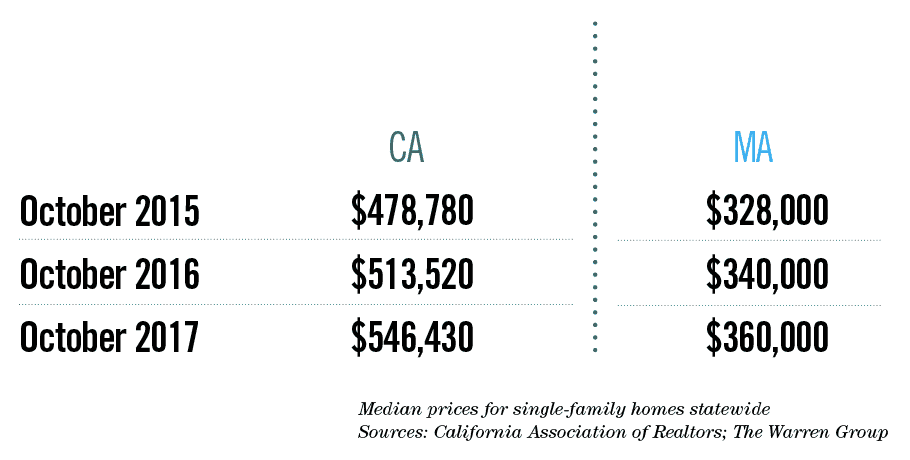Do we have to let our already messed up real estate market get as crazy as California’s before we take action?
That should be the question here in Massachusetts – and in particular on Beacon Hill – following the passage of a sweeping housing reform bill out on the Left Coast. Fed up with their state’s insane prices, California legislators finally put their foot down at the end of November, passing 14 separate bills to rein in a runway housing market.
A fee on refinancing and other real estate transactions – with the exceptions of sales – will raise $250 million a year for affordable housing, services for the homeless and local planning efforts. A proposal to issue $4 billion in bonds to build affordable housing for veterans and others will go on the statewide ballot in the fall of 2018, thanks to the new legislation.
But California’s housing reform package goes well beyond pumping money into new housing, as important as that is. In an effort that should have real resonance here, California’s revamp of its troubled housing market takes aim at the bureaucratic roadblocks and snob zoning that can bottle up the development of new housing on the local level.
Local communities perpetually delaying or killing valid housing proposals could find themselves on the hook for fines of at least $10,000 per unit, while also being forced to pick up attorney fees.
Cities and towns across California would also be eligible for subsidies to create special districts for new apartment and condominium developments. The local permitting process would also be streamlined for multifamily housing developments that meet certain criteria, such as including a number of affordable units.
Homelessness Spreads To The Suburbs
California lawmakers and Gov. Jerry Brown were prodded into action by the Sunshine State’s increasingly dire housing situation.
The median price of a home in San Francisco hit $1.45 million in the second quarter. In order to buy a home in the city, you’ll need to be pulling down nearly $300,000 annually. Of course, just 12 percent of San Franciscans actually meet that income threshold, a situation the Business Insider rightly declares “absurd.”
A similar story can be found across the Bay Area and Silicon Valley, with median prices in the million-dollar-and-up range the norm, not the exception.
Fifty-seven percent of California renters can’t afford their apartments while more than 40 percent of homeowners are in over their heads, struggling to pay mortgages that are beyond their means, writes Murtaza Baxamusa, director of planning and development for the San Diego County Building and Construction Trades Council Family Housing Corporation, in Shelterforce Weekly. Homelessness, once an overwhelmingly urban phenomenon, has been spreading into the state’s suburbs, he notes.
The median price of a home in California as a whole is expected to hit $561,000 next year, following a 7.2 percent jump in 2017, according to the California Association of Realtors. By contrast, the median home price in Massachusetts was $360,000 in October, a nearly 6 percent increase over October 2016, according to The Warren Group, publisher of Banker & Tradesman. And we thought our prices were crazy!
 Still, that should be cold comfort. While Massachusetts home values have not reached the insane levels California is now experiencing, just wait a few years. Many of the same factors that are driving up prices in Massachusetts – declining home construction combined with a rapidly expanding local economy – have been at work for years now in California.
Still, that should be cold comfort. While Massachusetts home values have not reached the insane levels California is now experiencing, just wait a few years. Many of the same factors that are driving up prices in Massachusetts – declining home construction combined with a rapidly expanding local economy – have been at work for years now in California.
State and local red tape has made it progressively more difficult for developers to build and meet market demand, leading to a large gap between what buyers want and what’s actually getting built.
In order to erase a shortage that has been building for decades, the Golden State will need to dramatically ramp up residential construction – to the tune of an additional 100,000 homes, condos and apartments per year, the state’s Legislative Analyst’s Office has found.
New Economy industries like high-tech and biotech have been driving job growth in hot spots like the Bay Area, creating more and more jobs – and more and more demand for a shrinking supply of homes.
All Bets Off In Boston
It all sound very similar to what has been happening in Greater Boston and across Massachusetts, except for one key detail: the response of California’s Legislature and governor to the crisis.
California lawmakers have responded to a big problem with some big solutions. On Beacon Hill, lawmakers have spent the last few years fruitlessly debating a zoning reform bill that is a pale shadow, when it comes to size and scope, of the housing crisis legislation California just passed.
And with Senate President Stanley Rosenberg having stepped aside amid an investigation into sexual abuse and assault allegations involving his husband, all bets are off.
There’s just no way of knowing when the State House will once again be back to normal again, such as it is, and paying heed to such small matters as the increasingly unbearable cost of housing in Massachusetts and the plight of middle-class families.




 |
| 



